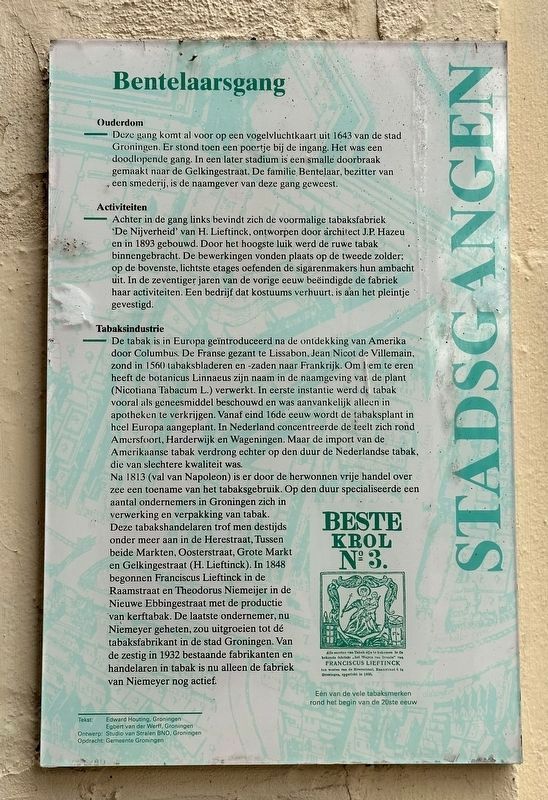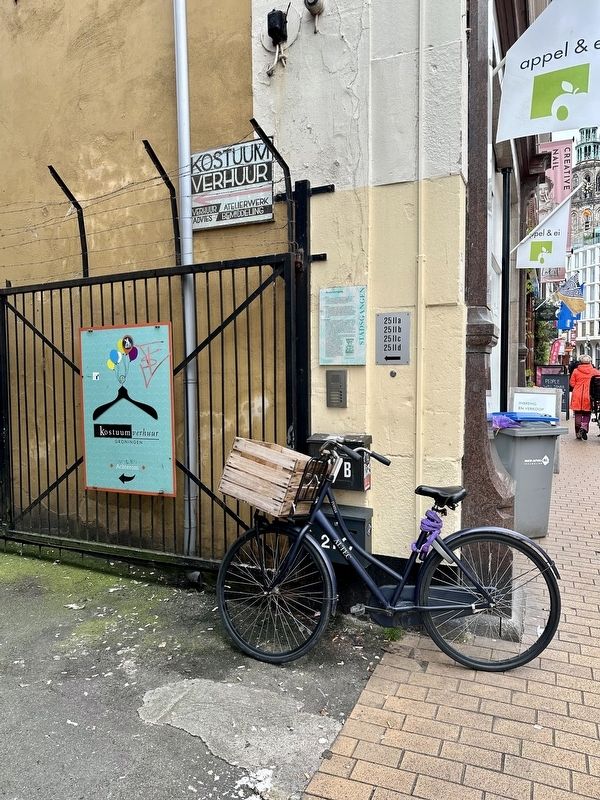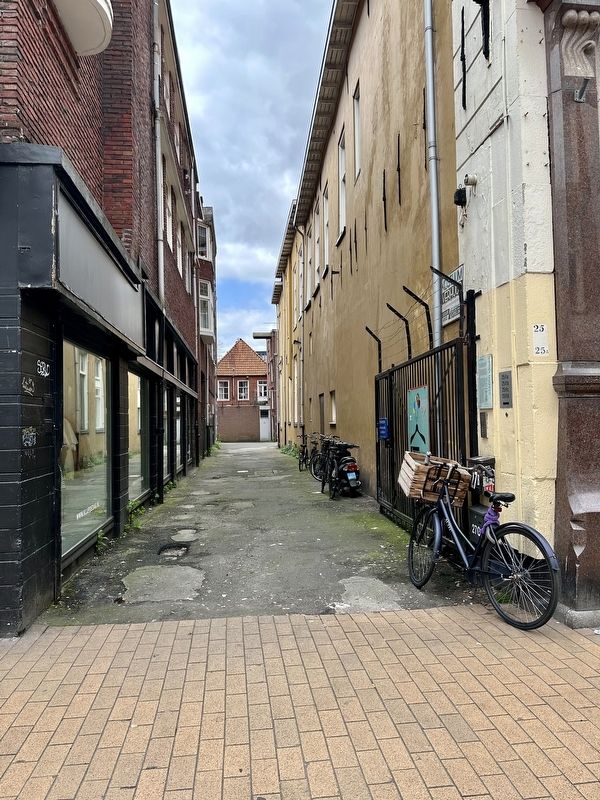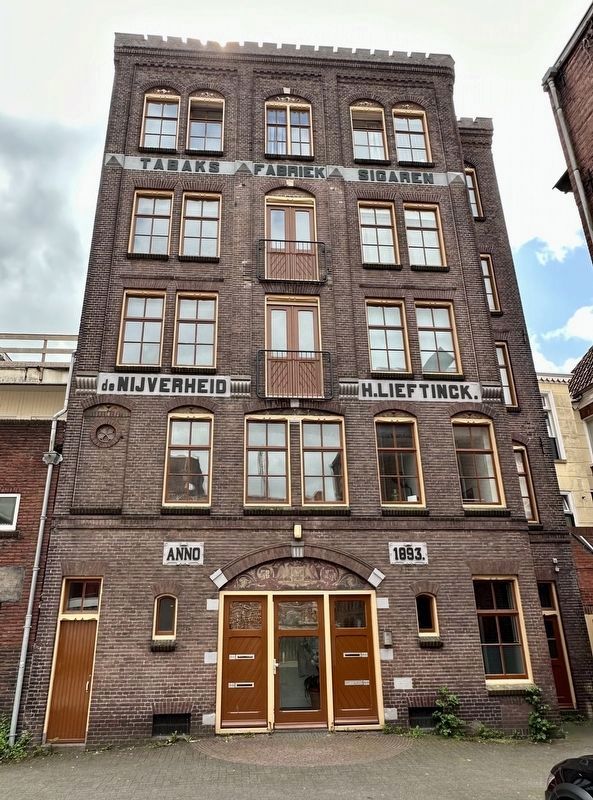Groningen, Netherlands — Northwestern Europe
Bentelaarsgang
— Stadsgangen —
Deze gang komt al voor op een vogelvluchtkaart uit 1643 van de stad Groningen. Er stond toen een poortje bij de ingang. Het was een doodlopende gang. In een later stadium is een smalle doorbraak gemaakt naar de Gelkingestraat. De familie Bentelaar, bezitter van, een smederij, is de naamgever van deze gang geweest.
Activiteiten
Achter in de gang links bevindt zich de voormalige tabaksfabriek 'De Nijverheid' van H. Lieftinck, ontworpen door architect J.P. Hazeu en in 1893 gebouwd. Door het hoogste luik werd de ruwe tabak binnengebracht. De bewerkingen vonden plaats op de tweede zolder; op de bovenste, lichtste etages oefenden de sigarenmakers hun ambacht uit. In de zeventiger jaren van de vorige eeuw beëindigde de fabriek haar activiteiten. Een bedrijf dat kostuums verhuurt, is aan het pleintje gevestigd.
Tabaksindustrie
De tabak is in Europa geïntroduceerd na de ontdekking van Amerika door Columbus De Franse gezant te Lissabon, Jean Nicot de Villemain, zond in 1560 tabaksbladeren en -zaden naar Frankrijk. Om lem te eren heeft de botanicus Linnaeus zijn naam in de naamgeving var de plant (Nicotiana Tabacum L.) verwerkt. In eerste instantie werd de tabaki vooral als geneesmiddel beschouwd en was aanvankelijk alleen in apotheken te verkrijgen. Vanaf eind 16de eeuw wordt de tabaksplant in heel Europa aangeplant. In Nederland concentreerde de teelt zich Amersfoort, Harderwijk en Wageningen. Maar de import van de Amerikaanse tabak verdrong echter op den duur de Nederlandse tabak, die van slechtere kwaliteit was.
Na 1813 (val van Napoleon) is er door de herwonnen vrije handel over zee een toename van het tabaksgebruik. Op den duur specialiseerde een aantal ondernemers in Groningen zich in verwerking en verpakking van tabak. Deze tabakshandelaren trof men destijds onder meer aan in de Herestraat, Tussen. beide Markten, Oosterstraat, Grote Markt en Gelkingestraat (H. Lieftinck). In 1848 begonnen Franciscus Lieftinck in de Raamstraat en Theodorus Niemeijer in de Nieuwe Ebbingestraat met de productie van kerftabak. De laatste ondernemer, nu Niemeyer geheten, zou uitgroeien tot dé tabaksfabrikant in de stad Groningen. Van de zestig in 1932 bestaande fabrikanten en handelaren in tabak is nu alleen de fabriek van Niemeyer nog actief.
Age
This alley already appears on a bird's-eye view map of the city of Groningen from 1643. There was then a gate at the entrance. It was a dead end. At a later stage, a narrow breakthrough was made to the Gelkingestraat. The Bentelaar family, owner of a blacksmith shop, has been the namesake of this alley.
Activities
At the end of the alley on the left is the former tobacco factory 'De Nijverheid' of H. Lieftinck, designed by architect J.P. Hazeu and built in 1893. The raw tobacco was brought in through the highest hatch. The operations took place in the second attic; the cigar makers practiced their craft on the top, best-lit floors. In the 1970s, the factory ceased its activities. A company that rents costumes is now located on the courtyard.
The Tobacco Industry
Tobacco was introduced to Europe after the discovery of America by Columbus. The French envoy in Lisbon, Jean Nicot de Villemain, sent tobacco leaves and seeds to France in 1560. To honor him, the botanist Linnaeus his name in the naming of the plant (Nicotiana Tabacum L.). Initially, tobacco was mainly regarded as a medicine and was initially only available in pharmacies. From the end of the 16th century, the tobacco plant was planted throughout Europe. In the Netherlands, cultivation was concentrated in Amersfoort, Harderwijk and Wageningen. However, imports of American tobacco eventually displaced Dutch tobacco, which was of poorer quality.
After 1813 (fall of
Napoleon) there was an increase in tobacco use due to the regained free trade by sea. In time, a number of entrepreneurs in Groningen specialized in the processing and packaging of tobacco. At the time, these tobacco merchants could be found in the Herestraat, between the two market squares, Oosterstraat, Grote Markt and Gelkingestraat (H. Lieftinck). In 1848 Franciscus Lieftinck on the Raamstraat and Theodorus Niemeijer on the Nieuwe Ebbingestraat started the production of cut tobacco. The last entrepreneur, named Niemeyer, would become the dominant tobacco manufacturer in the city of Groningen. Of the sixty tobacco manufacturers and dealers existing in 1932, only the Niemeyer factory is still active today.
Erected by Gemeente Groningen.
Topics. This historical marker is listed in these topic lists: Industry & Commerce • Roads & Vehicles. A significant historical year for this entry is 1643.
Location. 53° 13.052′ N, 6° 34.166′ E. Marker is in Groningen. Marker is at the intersection of Bentelaarsgang and Oosterstraat, on the right when traveling west on Bentelaarsgang. Touch for map. Marker is at or near this postal address: Oosterstraat 27B, Groningen 9711 NM, Netherlands. Touch for directions.
Other nearby markers. At least 8 other markers are within walking distance of this marker. Oosterstraat 44 (within shouting distance of this marker); De Drie Gezusters / The Three Sisters (about 120 meters away, measured
in a direct line); De bevrijding van Groningen / The Liberation of Groningen Memorial (about 180 meters away); Groningen Municipal Council Members Memorial (about 180 meters away); Feithhuis (about 180 meters away); Martinikerk / St. Martin Church (about 210 meters away); Martinitoren / St. Martin Tower (about 210 meters away); Provinciehuis / Provincial House (about 210 meters away). Touch for a list and map of all markers in Groningen.
Credits. This page was last revised on December 31, 2023. It was originally submitted on June 14, 2023, by Andrew Ruppenstein of Lamorinda, California. This page has been viewed 73 times since then and 19 times this year. Photos: 1, 2, 3, 4. submitted on June 14, 2023, by Andrew Ruppenstein of Lamorinda, California.



